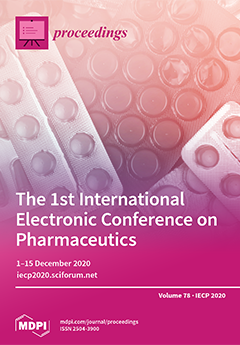Need Help?
Proceedings, 2021, IECP 2020
The 1st International Electronic Conference on Pharmaceutics
Online | 1–15 December 2020
Volume Editors:
Andrea Erxleben, National University of Ireland, Ireland
Elisabetta Gavini, University of Sassari, Italy
- Issues are regarded as officially published after their release is announced to the table of contents alert mailing list.
- You may sign up for e-mail alerts to receive table of contents of newly released issues.
- PDF is the official format for papers published in both, html and pdf forms. To view the papers in pdf format, click on the "PDF Full-text" link, and use the free Adobe Reader to open them.
Cover Story (view full-size image):
The 1st International Electronic Conference on Pharmaceutics (IECP 2020) brings together experts from academia and industry to share new ideas, technologies, and innovations in the broad areas of
[...] Read more.
The 1st International Electronic Conference on Pharmaceutics (IECP 2020) brings together experts from academia and industry to share new ideas, technologies, and innovations in the broad areas of pharmaceutical formulation, process development, drug delivery, pharmacokinetics, and biopharmaceutics. This event is organized around the following general topics: formulation of poorly soluble drugs; cyclodextrins in pharmaceutics; electrospun–sprayed drug delivery systems; advances in pharmacokinetics and drug metabolism; transdermal and topical drug delivery; brain drug delivery; nanomedicine for cancer.
Previous Issue
Next Issue
Issue View Metrics
Multiple requests from the same IP address are counted as one view.



